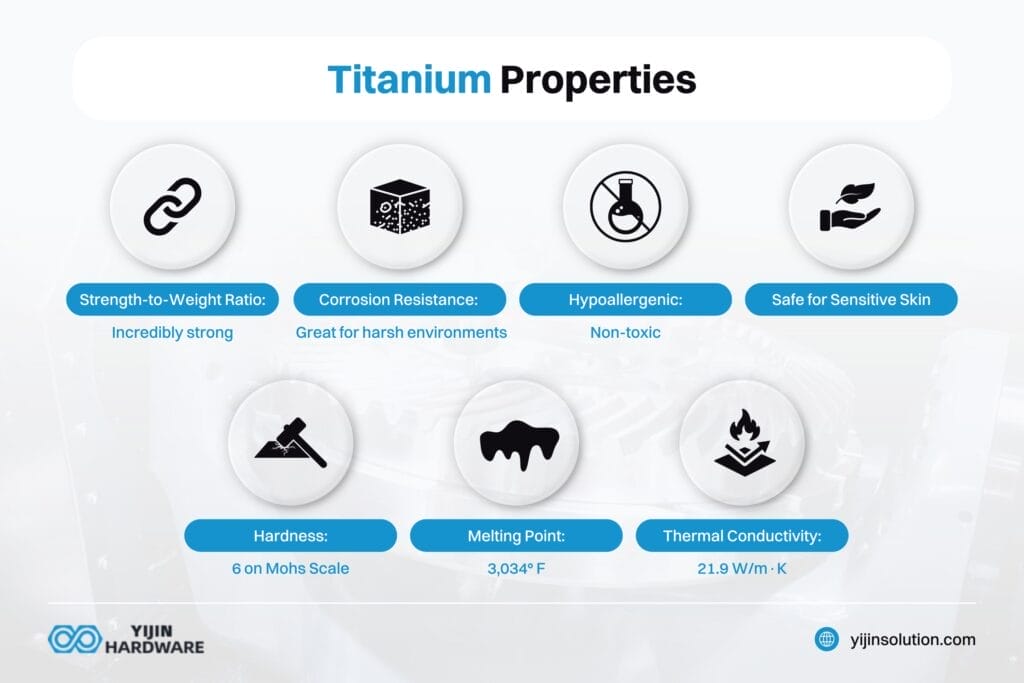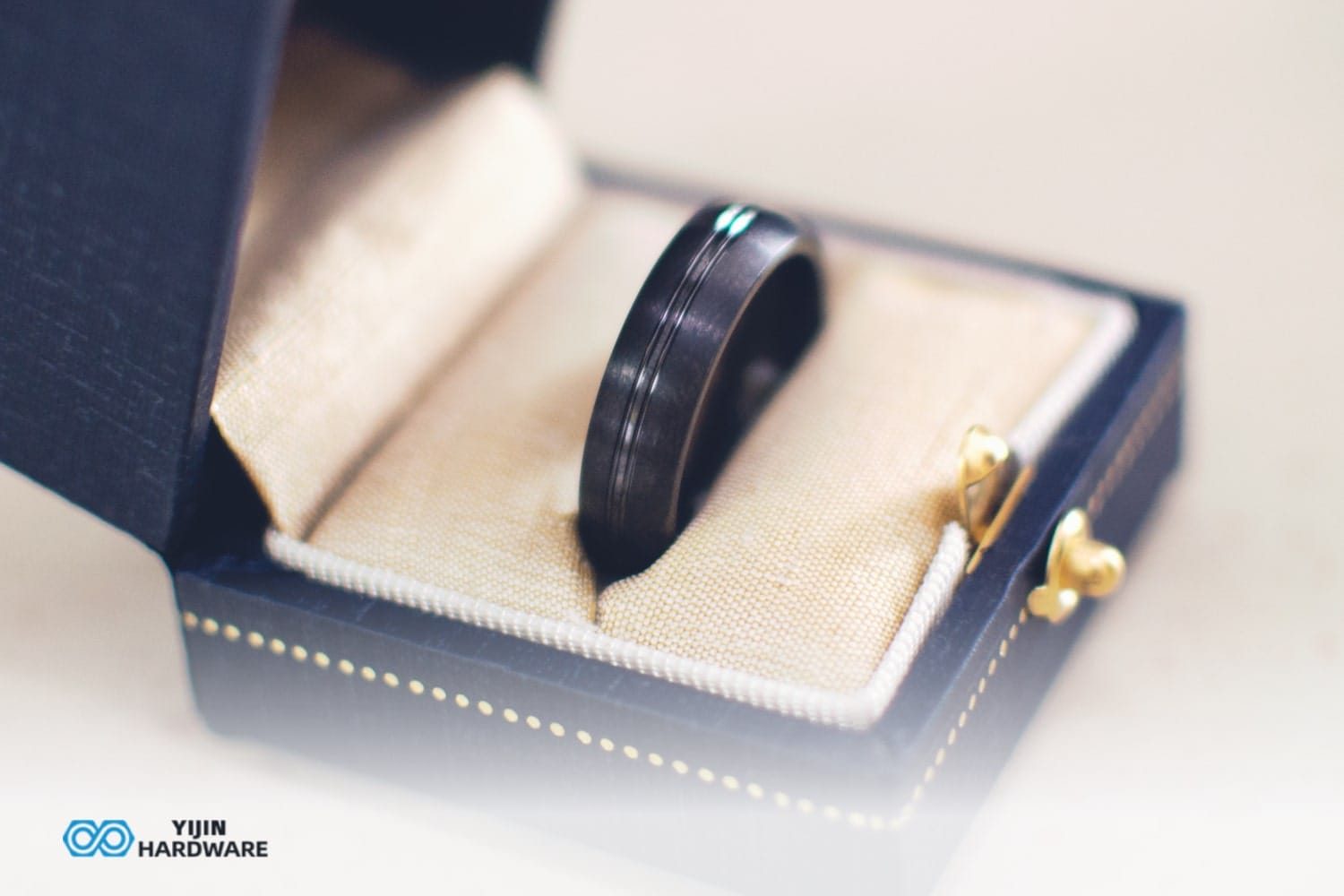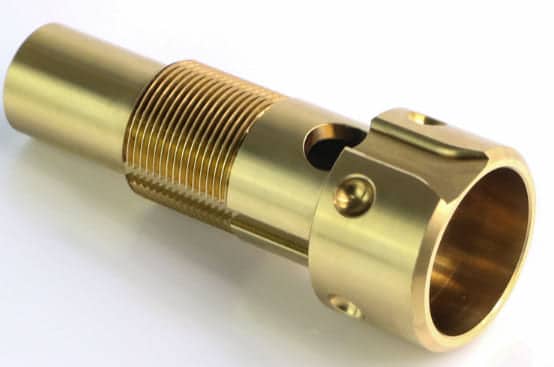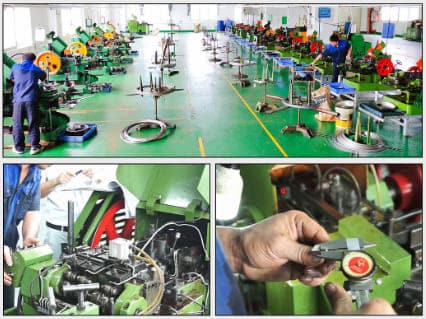Titanium and tungsten are two metals used in a variety of industries, from aerospace and medical to jewelry. Both of these precious metals are used for specific applications, so you don’t want to use the wrong one!
At Yijin Hardware, we pride ourselves on being an industry-leading CNC machining manufacturer. We want to ensure you use the optimal metal for your needs, so we’re going to weigh tungsten vs. titanium. Let’s analyze the differences between the two metals, what they’re used for, and more!
Key Takeaways
- Titanium is a light and strong material with hypoallergenic and corrosion-resistant properties.
- Tungsten is a heavy metal and more resistant to wear and tear and heat.
- Titanium is more expensive than tungsten, but tungsten is stronger than titanium.
- Tungsten is great for high-stress applications, whereas titanium works well for applications requiring lightweight metal.
What is Titanium?

Titanium (Ti) is a transition metal that has a silvery/white appearance. It has a great strength-to-weight ratio and is slightly lighter than steel, but just as strong.
Titanium comes from minerals like rutile and ilmenite, and sometimes you can alloy it with other elements to improve its properties. It can only be found naturally as an oxide, so it needs to be processed properly. Titanium can also be 3D printed into a few different essential components. After it has been made into an ingot, it can be laser-cut to your specific design.
Additionally, titanium is corrosion-resistant and hypoallergenic. This makes it a great choice for men’s jewelry as a titanium ring, especially for people with metal allergies.
You’ll often find titanium in aerospace applications and medical implants, because its hypoallergenic properties won’t cause unwanted reactions to your body.
Properties of Titanium

- Strength-to-Weight Ratio: Titanium is incredibly strong for its weight. This makes it a fantastic choice for applications where low weight is essential.
- Corrosion Resistance: Titanium creates a protective oxide layer, making it resistant to corrosion in harsh environments, like seawater and chlorine.
- Hypoallergenic: Titanium is non-toxic and is unlikely to cause allergic reactions. This is great for sensitive skin.
- Hardness: As titanium rates as a 6 on the Mohs scale, it is durable. However, with this Mohs hardness, it is more prone to scratches than tungsten.
- Thermal Properties: Titanium has a melting point of about 3,034° F and a thermal conductivity of 21.9 W/m·K.
Types of Titanium
If you go with titanium, you should know that there are quite a few types! They can be broken down into commercially pure grades and titanium alloys:
Commercially Pure Titanium Grades
- Grade 1: The softest titanium with powerful corrosion resistance. It’s best for cold forming.
- Grade 2: This titanium is quite common because it has a great balance of strength and flexibility. Many titanium wedding ring buyers tend to go for Grade 2.
- Grade 3: This is a higher strength of titanium, usually used for aerospace applications and equipment.
- Grade 4: This one has the highest hardness of any pure grade, usually used in medical devices.
Titanium Alloys
- Ti-6Al-4V (Grade 5): This is the most common titanium alloy — it has high strength and good corrosion resistance. You’ll see Grade 5 titanium in aerospace and medical devices.
- Ti-6Al-7Nb (Grade 7): This alloy has even higher corrosion resistance, which is best for chemical processing.
- Ti-3Al-2.5V (Grade 9): Grade 9 titanium alloy has the highest strength and corrosion resistance, usually found in aircraft hydraulic piping.
Pros and Cons of Titanium
Let’s get into the advantages and disadvantages of titanium for everyday wear, products, and more. Here are the pros and cons:
| Pros | Cons |
|---|---|
| High Strength-to-Weight Ratio: Light but very strong | Higher Cost: More expensive due to extraction and processing |
| Powerful Corrosion Resistance: Not easily corroded — ideal for marine and chemical environments | Difficult to Machine: Specialized tools and techniques are needed |
| Hypoallergenic: Safe for people with metal allergies | Limited High-Temperature Performance: Less effective in high-temperature conditions compared to some alloys |
| Good Weldability: Can be welded with proper techniques |
What is Tungsten?

Tungsten (W) is a heavy metal with high hardness and a high melting point. It is typically taken from ores like wolframite and scheelite. Tungsten carbide jewelry has a nice weight to it, much like gold and platinum, but it is a lot more affordable.
Tungsten is sometimes alloyed with carbon to create tungsten carbide, which has a high durability. Moreover, many people tend to go for tungsten carbide rings for their wedding. Tungsten is also more resistant to wear and tear and heat. Steel can also be alloyed with tungsten to improve its strength.
Many people choose to buy and engrave tungsten rings, as they have a modern aesthetic and are scratch-resistant. You will also find tungsten in industrial tools, such as abrasives and cutting tools. Tungsten is also a popular choice for filaments and electrical contacts.
Properties of Tungsten

- Density: Tungsten is one of the densest metals. It has a density of 19.25 g/cm³, making it great for tasks that need a heavy metal.
- Hardness: Tungsten has a Mohs hardness of 9. This renders it very scratch-resistant, which is important for tungsten wedding bands.
- Melting Point: Tungsten has the highest melting point of all metals at 6,192° F. This means it’s great for high-temperature applications.
- Brittleness: Even though it’s very hard, tungsten can be brittle, so it can shatter after an impact.
- Thermal Conductivity: Tungsten has a thermal conductivity of 173 W/m·K, which is quite high. High thermal conductivity is important for applications that require efficient heat dissipation.
Types of Tungsten
Tungsten is usually found in two forms: metal and alloys. Tungsten metal is pure tungsten, usually used for applications that need high strength and hardness. Here are the two main tungsten alloys:
- Tungsten Carbide: This is a blend of tungsten and carbon. It is quite hard and has great wear resistance, so it’s frequently used in cutting tools and jewelry.
- Tungsten Heavy Alloys: This is made of tungsten and other metals. These alloys have high density and strength, and are often used in military applications.
Pros and Cons of Tungsten
Tungsten metals have their benefits and drawbacks, like any other metal. Here are the pros and cons:
| Pros | Cons |
|---|---|
| Extreme Hardness: Due to its hardness, tungsten has high scratch resistance, making it great for everyday wear. | Brittleness: Tungsten rings can shatter after heavy impact. |
| High Melting Point: A great option for high-temperature applications. | Weight: Heavier than titanium, which can be an issue for applications requiring lightweight metal; strength makes it almost impossible to resize. |
| Density: Provides extra stability and weight in applications like counterweights. | Difficult to Machine: Tungsten, like titanium, needs specialized methods for shaping and fabrication. |
Titanium vs. Tungsten
Now that you know everything there is to know about tungsten and titanium, it’s time to weigh up the differences. Here are the core differences between titanium and tungsten.
Strength
So, is tungsten stronger than titanium? The answer is yes! In terms of raw tensile tungsten vs. titanium strength, tungsten has 142,000 psi, whereas titanium has 63,000 psi. However, titanium has better impact resistance because of its ductility.
Weight
If you’re considering titanium and tungsten rings, it might be better to go for titanium in terms of weight. Titanium weighs around 60% less than tungsten! That means it’s best to choose titanium for jewelry or aerospace equipment.
Cost
Titanium is usually more expensive than tungsten because of the extra extraction and processing costs. However, the price can vary depending on specific alloys and market conditions.
Applications
If you’re trying to choose titanium or tungsten, you need to keep your application in mind. Tungsten is heavier but better for high-stress applications, like industrial machinery and some jewelry, if combined with carbide.
Durability and Maintenance
If scratch resistance is an important part of your application, we recommend going for tungsten. For rings, this material best suits people who work with their hands a lot. But, tungsten is also brittle, so it can easily crack if dropped or placed under a lot of pressure. In contrast, titanium is not scratch-resistant, but is also less likely to shatter or bend under increased stress.
Emergency Removal
If you’re choosing between tungsten and titanium rings, there might come a time when it needs to be removed in an emergency. Titanium rings are easier to remove in comparison to tungsten. This is because tungsten can only be cut with special tools, while titanium can usually be cut with standard jewelry cutters.
Yijin Hardware: Affordable Machining Solutions
When it comes down to it, both tungsten and titanium have great advantages that make them suitable for specific projects. Some people choose tungsten because of its extreme hardness and scratch resistance. On the other hand, others choose titanium for its lightweight, hypoallergenic, and corrosion-resistant properties.
When you make your choice, keep your project’s specific needs, budget, and personal preferences in mind.
Yijin Hardware offers an on-demand manufacturing solution for your tungsten or titanium project needs. We offer a wide range of services to bring your vision to life! Get in touch for a quote or if you need some advice on your project’s metal choices.
Tungsten vs. Titanium FAQs
Does titanium warp when machined?
Some big titanium alloy parts can warp when machined. It can be quite expensive to fix or replace these warped parts. This happens because titanium has low thermal conductivity, causing heat to build up in the material during machining. Specialized techniques, such as using proper cutting fluids and lower speeds, can help reduce the risk of warping. However, precision in machining titanium is crucial to avoid such costly issues.
Can pure tungsten be machined?
Yes, pure tungsten can be machined with CNC turning, milling, or drilling. However, due to its high hardness and brittleness, machining tungsten requires specialized equipment and techniques. Tungsten has a high melting point and is dense, so maintaining optimal cutting speeds and cooling during machining is essential to avoid damaging tools.
What lasts longer, tungsten or titanium?
Tungsten lasts longer than titanium, but this depends on the environment. Tungsten is more durable and harder than titanium, but it can shatter under a lot of pressure. While tungsten excels in abrasion resistance and wear, making it ideal for applications like cutting tools, titanium has better corrosion resistance, particularly in marine and chemical environments. Titanium is also more flexible and lightweight, so it’s a better choice for applications where the strength-to-weight ratio is crucial, such as aerospace components.
Back to Top: Tungsten vs. Titanium

 info@yijinsolution.com
info@yijinsolution.com (+86) 188-2253-7569
(+86) 188-2253-7569







